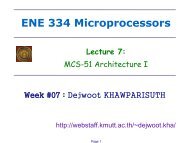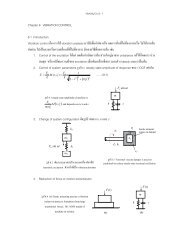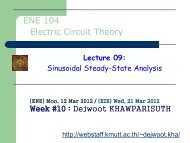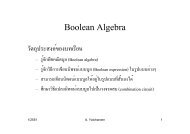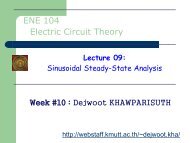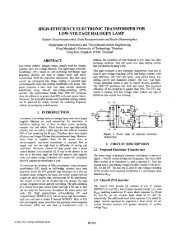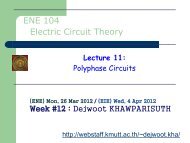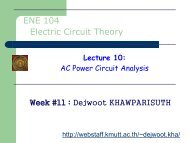Model-based fault-detection and diagnosis ... - web page for staff
Model-based fault-detection and diagnosis ... - web page for staff
Model-based fault-detection and diagnosis ... - web page for staff
Create successful ePaper yourself
Turn your PDF publications into a flip-book with our unique Google optimized e-Paper software.
4ðtÞ ¼’ gðtÞ<br />
’ rðtÞ<br />
v<br />
(14)<br />
Each of the residuals is decoupled from one measured<br />
signal. r1 is independent from fg, r2 from U, r3 from I, r4<br />
from all but fr.(fr is assumed to be correct. It can directly be<br />
supervised by a logic evaluation within the motor electronics).<br />
Fig. 7 shows measured signals, parameter estimates<br />
<strong>and</strong> residuals <strong>for</strong> five different implemented <strong>fault</strong>s. The<br />
actuator was operating in closed loop with slow triangle<br />
changes of the reference variable (setpoint). The <strong>fault</strong><strong>detection</strong><br />
methods, including differentiating filter (SVF)<br />
were implemented on a digital signal processor TI TMS<br />
320 C40 with signal sampling period T0 = 1 ms. The results<br />
<strong>for</strong> <strong>fault</strong>-<strong>detection</strong> are summarized in Table 8.<br />
The sign <strong>and</strong> size of changes <strong>for</strong> the parameter estimates<br />
with FDSFI clearly allow to identify the parametric <strong>fault</strong>s<br />
<strong>and</strong> <strong>for</strong> the parity residuals the respective additive (offset)<br />
sensor <strong>fault</strong>s. But there are also cross couplings: <strong>for</strong> parametric<br />
<strong>fault</strong>s some residuals show changes <strong>and</strong> <strong>for</strong> sensor<br />
additive <strong>fault</strong>s some parameter estimates change (except <strong>for</strong><br />
fg), which can all be interpreted by the equations used.<br />
According to (Gertler, 1998) the symptom pattern is weakly<br />
isolating as a parametric <strong>fault</strong> of R <strong>and</strong> an additive <strong>fault</strong> in U<br />
differ only in one symptom. However, all <strong>fault</strong>s can be<br />
isolated. Including the st<strong>and</strong>ard deviation of the symptoms<br />
isolability can be improved (Moseler, 2001). By processing<br />
eight symptoms with a rule-<strong>based</strong> fuzzy-logic <strong>diagnosis</strong><br />
system, finally 10 different <strong>fault</strong>s could be diagnosed (Moseler<br />
<strong>and</strong> Müller, 2000b; Moseler, 2001).<br />
If the input signal U stays approximately constant, only<br />
parity equations should be applied, which then may indicate<br />
<strong>fault</strong>s. Then <strong>for</strong> isolating or diagnosing the <strong>fault</strong>s a test<br />
signal on U can be applied <strong>for</strong> short time to gain deeper<br />
in<strong>for</strong>mation. Hence, by applying both parameter estimation<br />
<strong>and</strong> parity equations a good <strong>fault</strong> coverage can be obtained.<br />
Because the position sensors of the rotor fr <strong>and</strong> the shaft fg<br />
yield redundant in<strong>for</strong>mation, sensor <strong>fault</strong>-<strong>detection</strong> <strong>for</strong> fg<br />
was used to reconfigure the closed loop after failure of fg<br />
by using fr as control variable (Moseler, 2001). The<br />
described combined <strong>fault</strong>-<strong>detection</strong> methodology needs<br />
about 8 ms calculation time on a 16 bit microcontroller.<br />
There<strong>for</strong>e, online implementation in a smart actuator is<br />
possible by only measuring four easy accessible variables<br />
U, I <strong>and</strong> vr <strong>and</strong> fg.<br />
4.2. Supervision of the lateral driving behavior of<br />
passenger cars<br />
Based on theoretical modeling of the lateral behavior of a<br />
passenger car, the characteristic velocity is considered as a<br />
parameter determining the kind of the steering behavior, like<br />
understeering or oversteering. This characteristic value is<br />
used as a ‘‘<strong>fault</strong>-<strong>detection</strong> feature’’ due to Fig. 1 to classify the<br />
behavior with regard to normal or critical driving behavior <strong>and</strong><br />
such indicating also <strong>fault</strong>y behavior, like instability.<br />
R. Isermann / Annual Reviews in Control 29 (2005) 71–85 79<br />
Fig. 7. Resulting symptoms from parameter estimation <strong>and</strong> parity equations<br />
by measuring U(t), I(t), v(t),f g(t) <strong>and</strong> f r(t).<br />
Table 8<br />
Parameter deviations <strong>and</strong> parity equation residuals <strong>for</strong> different actuator<br />
<strong>fault</strong>s (0 no significant change; + increase; ++ large increase;<br />
large decrease)<br />
decrease;<br />
Faults Parameter estimates Residuals of parity equations<br />
ˆR ˆ kE ĉf r1 r2 r3 r4<br />
Incr. R + 0 0 + 0 + 0<br />
Incr. c f 0 0 ++ + ++ 0<br />
Offset U + + 0 ++ 0 ++ 0<br />
Offset fg 0 0 0 + 0 0 0<br />
Offset Ib ++ ++ ++ 0




